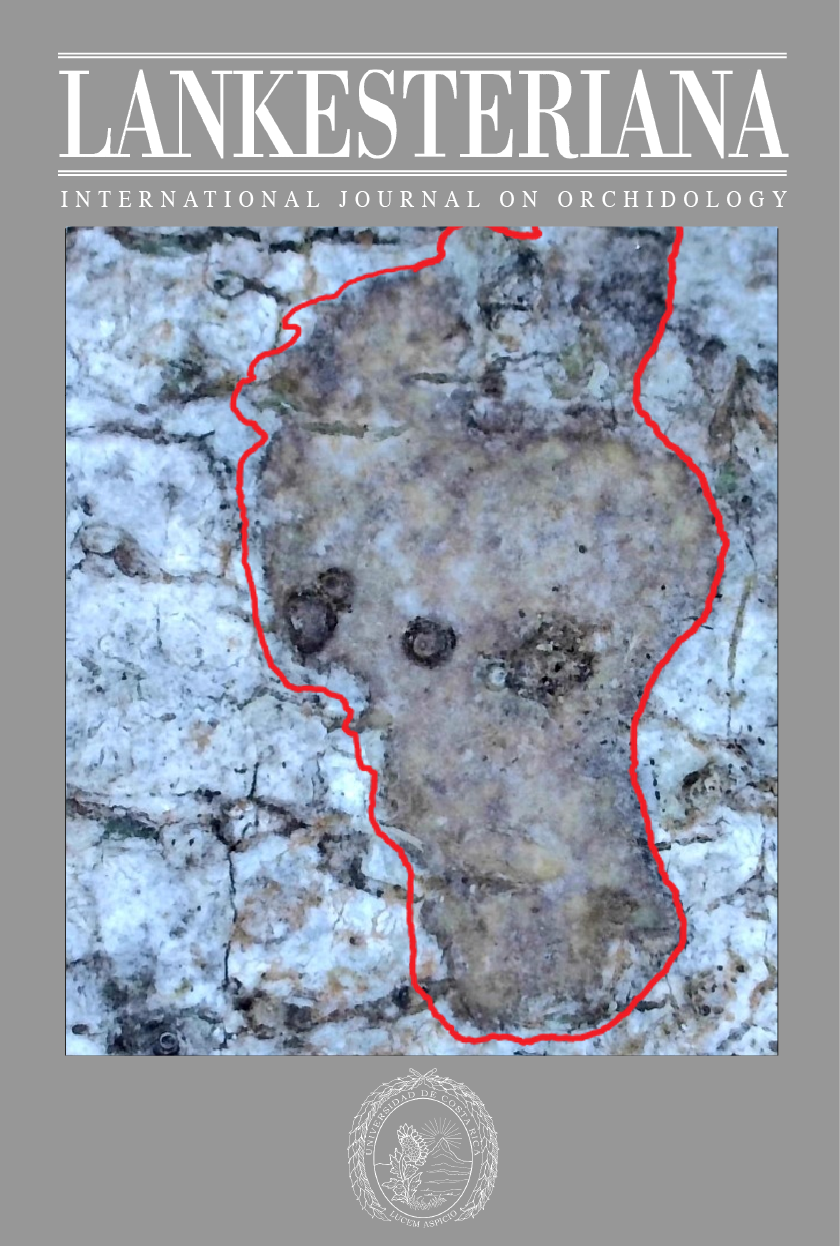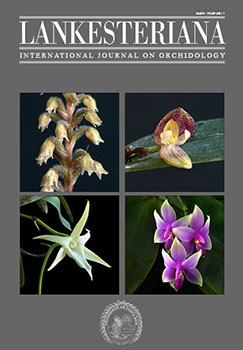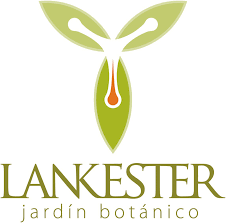Host suitability for germination differs from that of later stages of development in a rare epiphytic orchid
DOI:
https://doi.org/10.15517/lank.v24i1.59617Palabras clave:
dinámica comunitaria, dinámica poblacional, epífitas, forófitos, germinación, OrchidaceaeResumen
Exploramos la utilización de árboles y los patrones de germinación de la orquídea epífita, Psychilis kraenzlinii. Encontramos que P. kraenzlinii crece en un subconjunto de las especies de árboles disponibles y muestra preferencia por la endémica Machaonia portoricensis. La orquídea prefiere árboles con corteza lisa y alta capacidad de sostener agua y baja capacidad de retención de agua. Las condiciones microclimáticas bajo las cuáles los embriones empienzan etapas pre-germinacíon, reflejan los de la orquídea adulta, pero las condiciones bajo las cuáles los embriones llegan a etapas de germinación no. Lo que sugiere que los sitios de germinación adecuados no son necesariamente los lugares donde mejor se producirá el desarrollo a etapas más avanzadas de la germinación.
Descargas
Citas
Ackerman, J. D. (1986). Coping with the epiphytic existence: pollination strategies. Selbyana, 9(1), 52–60.
Ackerman, J. D. & Collaborators. (2014). Orchid flora of the Greater Antilles. Memoirs of the New York Botanical Garden, 105.
Ackerman, J. D., Montalvo, A. M. & Vera, A. M. (1989). Epiphyte host specificity of Encyclia krugii, a Puerto Rican endemic orchid. Lindleyana, 4(2), 74–77.
Ackerman, J. D., Sabat, A. & Zimmerman, J. K. (1996). Seedling establishment in an epiphytic orchid: an experimental study of seed limitation. Oecologia, 106(2), 192–198. doi: 10.1007/BF00328598
Adhikari, Y. P. & Fischer, A. (2011). Distribution pattern of the epiphytic orchid Rhynchostylis retusa under strong human influence in Kathmandu valley, Nepal. Botanica Orientalis: Journal of Plant Science, 8, 90–99. doi: 10.3126/botor.v8i0.5956
Aragón, S. & Ackerman, J. D. (2004). Does flower color variation matter in deception pollinated Psychilis monensis (Orchidaceae)? Oecologia, 138(3), 405–413. doi: 10.1007/s00442-003-1443-9
Arditti, J. (1992). Fundamentals of orchid biology. Wiley.
Axelrod, F. S. (2011). A systematic vandemecum to the vascular plants of Puerto Rico. Brit Press, 34.
Barthelme, S. (2023). imager: Image processing library based on ‘CImg’ (R package version 0.45.2). Retrieved from https://CRAN.R-project.org/package=imager
Benzing, D. H. (1979). Alternative interpretations for the evidence that certain orchids and bromeliads act as shoot parasites. Selbyana 5(2), 135–144.
Benzing, D. H. (1990). Vascular epiphytes. General biology and related biota. Cambridge University Press.
Benzing, D. H. (2004). Vascular epiphytes. In: D. M. Lowman & H. B. Rinker (2nd Ed.), Forest canopies (2nd Ed.) (pp. 175–211). Elsevier.
Bidartondo, M. I. (2005). The evolutionary ecology of myco‐heterotrophy. New Phytologist, 167(2), 335–352. doi: 10.1111/j.1469-8137.2005.01429.x
Bidartondo, M. I. & Read, D. J. (2008). Fungal specificity bottlenecks during orchid germination and development. Molecular Ecology, 17(16), 3707–3716. doi: 10.1111/j.1365-294X.2008.03848.x
Brandner, S. (2005). An assessment of the fungal specificity of the orchid sub-tribe Pterostylis. Centre for Australian National Biodiversity Research and Australian National Herbarium. Retrieved from https://www.cpbr.gov.au/cpbr/summer-scholarship/2005-projects/brandner-susan-orchids/index.html
Cabrera-García, B., Guerrero, A., Folgado, R., Jimenez, F. & Serra, C. (2023) Biología reproductiva de Psychilis truncata (Orchidaceae) en Arroyo Corral, Partido, Dajabón, República Dominicana. Moscosoa, 21, 99–114.
Callaway, R. M., Reinhart, K. O., Moore, G. W., Moore, D. J. & Pennings, S. C. (2002). Epiphyte host preferences and host traits: mechanisms for species-specific interactions. Oecologia, 132(2), 221–230. doi: 10.1007/s00442-002-0943-3
Crain, B. J., Sánchez-Cuervo, A. M. & Deren, V. (2022). Mixed evidence of a commensal relationship between a rare epiphytic orchid and cohabiting bryophytes. Botanical Journal of the Linnean Society, 201(4), pp. doi: https://doi.org/10.1093/botlinnean/boac049
Departamento de Recursos Naturales. (2015). El Bosque Estatal de Susua. Retrieved from http://drna.pr.gov/wp-content/uploads/2015/04/El-Bosque-Estatal-de-Susúa.pdf
Diez, J. M. (2007). Hierarchical patterns of symbiotic orchid germination linked to adult proximity and environmental gradients. Journal of Ecology, 95(1), 159–170.10.1111/j.1365-2745.2006.01194.x
Fay, M. F. (2018). Orchid conservation: how can we meet the challenges in the twenty-first century? Botanical Studies, 59(16), 1–6. doi: 10.1186/s40529-018-0232-z
Fernández, M., Kaur, J. & Sharma, J. (2023). Co-occurring epiphytic orchids have specialized mycorrhizal fungal niches that are also linked to ontogeny. Mycorrhiza, 33(1–2), 1–19. doi: 10.1007/s00572-022-01099-w
Frei, S. J. K. (1973). Effect of bark substrate on germination and early growth of Encyclia tampensis seeds. American Orchid Society Bulletin, 42(8), 701–708.
Frei, S. J. K. & Dodson, C. H. (1972). The chemical effect of certain bark substrates on the germination and early growth of epiphytic orchids. Bulletin of the Torrey Botanical Club, 99(6), 301–307. doi: https://doi.org/10.2307/2997072
Gentry, A. H. & Dodson, C. H. (1987). Diversity and biogeography of neotropical vascular epiphytes. Annual Missouri Botanical Garden, 74(2), 205–233. doi: https://doi.org/10.2307/2399395
González-Orellana, N., Salazar-Mendoza, A., Numan, Y. & Ackerman, J. D. (2022). Understanding orchid conservation, one species at a time. Orchids, 91(12), 914–919.
Gowland, K. M., Wood, J., Clements, M. A. & Nicotra, A. B. (2011). Significant phorophyte (substrate) bias is not explained by fitness benefits in three epiphytic orchid species. American Journal of Botany, 98(2), 197–206. Doi: 10.3732/ajb.1000241
Gravendeel, B., Smithson, A., Slik, F. J. W. & Schuiteman, A. (2004). Epiphytism and pollinator specialization: drivers for orchid diversity? Philosophical Transactions of the Royal Society London B, 359, 1523–1535.
Hietz, P. & Hietz‐Seifert, U. (1995). Composition and ecology of vascular epiphyte communities along an altitudinal gradient in central Veracruz, Mexico. Journal of Vegetation Science, 6(4), 487–498. Doi: https://doi.org/10.2307/3236347
Izuddin, M., Srivathsan, A., Lee, A. L., Yam, T. W. & Webb, E. L. (2019a). Availability of orchid mycorrhizal fungi on roadside trees in a tropical urban landscape. Scientific Reports, 9(1), 1–12. Doi: 10.1038/s41598-019-56049-y
Izuddin, M., Yam, T. W. & Webb, E. L. (2019b). Germination niches and seed persistence of tropical epiphytic orchids in an urban landscape. Journal of Plant Research, 132(3), 383–394. Doi: 10.1007/s10265-019-01110-0
Jacquemyn, H., Brys, R., Vandepitte, K., Honnay, O., Roldán‐Ruiz, I. & Wiegand, T. (2007). A spatially explicit analysis of seedling recruitment in the terrestrial orchid Orchis purpurea. New Phytologist, 176(2), 448–459. Doi: 10.1111/j.1469-8137.2007.02179.x
Jersáková, J. & Malinová, T. (2007). Spatial aspects of seed dispersal and seedling recruitment in orchids. New Phytologist, 176(2), 237–241. Doi: 10.1111/j.1469-8137.2007.02223.x
Khamchatra, N. M., Dixon, K., Chayamarit, K., Apisitwanich, S. & Tantiwiwat, S. (2016). Using in situ seed baiting technique to isolate and identify endophytic and mycorrhizal fungi from seeds of a threatened epiphytic orchid, Dendrobium friedericksianum Rchb.f. (Orchidaceae). Agriculture and Natural Resources, 50(1), 8–13. doi: https://doi.org/10.1016/j.anres.2016.01.002
Kartzinel, T. R., Trapnell, D. W. & Shefferson, R. P. (2013). Highly diverse and spatially heterogeneous mycorrhizal symbiosis in a rare epiphyte is unrelated to broad biogeographic or environmental features. Molecular Ecology, 22(23), 5949–5961. doi: 10.1111/mec.12536
Laube, S. & Zotz, G. (2006). Neither host-specific nor random: vascular epiphytes on three tree species in a Panamanian lowland forest. Annals of Botany, 97(6), 1103–1114. doi: 10.1093/aob/mcl067
McCormick, M. K., Taylor, D. L., Whigham, D. F. & Burnett Jr, R. K. (2016). Germination patterns in three terrestrial orchids relate to abundance of mycorrhizal fungi. Journal of Ecology, 104(3), 744–754. doi: https://doi.org/10.1111/1365-2745.12556
Meng, Y. Y., Fan, X. L., Zhou, L. R., Shao, S. C., Liu, Q., Selosse, M. A. & Gao, J. Y. (2019a). Symbiotic fungi undergo a taxonomic and functional bottleneck during orchid seeds germination: a case study on Dendrobium moniliforme. Symbiosis, 79, 205–212. doi: 10.1007/s13199-019-00647-x
Meng, Y. Y., Zhang, W. L., Selosse, M. A. & Gao, J. Y. (2019b). Are fungi from adult orchid roots the best symbionts at germination? A case study. Mycorrhiza, 29(5), 541–547. doi: 10.1007/s00572-019-00907-0
Migenis, L. E. & Ackerman, J. D. (1993). Orchid—phorophyte relationships in a forest watershed in Puerto Rico. Journal of Tropical Ecology, 9(2), 231–240. doi: 10.1017/S0266467400007227
Miller, J. S., Krupnick, G. A., Stevens, H., Porter-Morgan, H., Boom, B., Acevedo-Rodríguez, P., Ackerman, J. D., Kolterman, D., Santiago, E., Torres, C. & Velez, J. (2013). Toward Target 2 of the Global Strategy for Plant Conservation: An Expert Analysis of the Puerto Rican Flora to Validate New Streamlined Methods for Assessing Conservation Status. Annals of the Missouri Botanical Garden, 99(2), 199–205. doi: https://doi.org/10.3417/2011121
Miller, G., & Lugo, A. E. (2009). Guide to the ecological systems of Puerto Rico. USDA, IITF-GTR-35.
Myers, N., Mittermeier, R. A., Mittermeier, C. G., Da Fonseca, G. A. & Kent, J. (2000). Biodiversity hotspots for conservation priorities. Nature, 403(6772), 853–858. doi: https://doi.org/10.1038/35002501
Otero, J. T., Aragón, S. & Ackerman, J. D. (2007). Site variation in spatial aggregation and phorophyte preference in Psychilis monensis (Orchidaceae). Biotropica, 39(2), 227–231. doi: 10.1111/j.1744-7429.2006.00258.x
Otero, J. T., Bayman, P. & Ackerman, J. D. (2005). Variation in mycorrhizal performance in the epiphytic orchid Tolumnia variegata in vitro: the potential for natural selection. Evolutionary Ecology, 19, 29–43. doi: 10.1007/s10682-004-5441-0
Otero, J. T. & Flanagan, N. S. (2006). Orchid diversity ¬– beyond deception. Trends in Ecology and Evolution, 21(2), 64–65. doi: https://doi.org/10.1016/j.tree.2005.11.016
Petrolli, R., Augusto Vieira, C., Jakalski, M., Bocayuva, M. F., Vallé, C., Cruz, E. D. S., Selosse, M., Martos, F. & Kasuya, M. C. M. (2021). A fine‐scale spatial analysis of fungal communities on tropical tree bark unveils the epiphytic rhizosphere in orchids. New Phytologist, 231(5), 2002–2014. doi: 10.1111/nph.17459
Petrolli, R., Zinger, L., Perez‐Lamarque, B., Collobert, G., Griveau, C., Pailler, T., Selosse, M. & Martos, F. (2022). Spatial turnover of fungi and partner choice shape mycorrhizal networks in epiphytic orchids. Journal of Ecology, 110(11), 2568–2584. doi: https://doi.org/10.1111/1365-2745.13986
Petter, G., Wagner, K., Wanek, W., Sánchez Delgado, E. J., Zotz, G., Cabral, J. S. & Kreft, H. (2016). Functional leaf traits of vascular epiphytes: vertical trends within the forest, intra‐and interspecific trait variability, and taxonomic signals. Functional Ecology, 30(2), 188–198. doi: https://doi.org/10.1111/1365-2435.12490
Phillips, R. D., Reiter, N. & Peakall, R. (2020). Orchid conservation: from theory to practice. Annals of Botany, 126(3), 345–362. doi: https://doi.org/10.1093/aob/mcaa093
Pierce, S. & Belotti, J. (2011). The Conservation of Terrestrial Orchids from the Alps to the Po Plain Lombardy. Parco delle Orobie Bergamasche and Centro Flora Autoctona della Regione Lombardia. Italy: Galbiate LC.
Rasmussen, H. N. (1995). Terrestrial orchids: from seed to mycotrophic plant. United Kingdom: Cambridge University Press.
Rasmussen, H. N., Dixon, K.W., Jersáková, J. & Těsǐtelová, T. (2015). Germination and seedling establishment in orchids: a complex of requirements. Annals of Botany, 116(3), 391–402. doi: 10.1093/aob/mcv087
Rasmussen, H. N. & Rasmussen, F. N. (2018). The epiphytic habitat on a living host: reflections on the orchid-tree relationship. Botanical Journal of the Linnean Society, 186(4), 456–472. https://doi.org/10.1093/botlinnean/box085
Sanford, W. W. (1974). The Ecology of Orchids (pp. 1–100). In: C. L. Withner (1st Ed.), The orchids scientific studies.
Sauleda, R. P. (1988). A revision of the genus Psychilis Rafinesque (Orchidaceae). Phytologia, 65, 1–33.
Sáyago, R., Lopezaraiza-Mikel, M., Quesada, M., Álvarez-Añorve, M. Y., Cascante-Marín, A. & Bastida, J. M. (2013). Evaluating factors that predict the structure of a commensalistic epiphyte–phorophyte network. Proceedings of the Royal Society B, 280(1756), 20122821. doi:https://doi.org/10.1098/rspb.2012.2821
Siaz‐Torres, S. S., Mora‐Olivo, A., Arellano‐Méndez, L. U., Vanoye‐Eligio, V., Flores‐Rivas, J. & de la Rosa‐Manzano, E. (2021). Contribution of peeling host for epiphyte abundance in two tropical dry forests in the “El Cielo Biosphere Reserve”, Mexico. Plant Species Biology, 36(2), 269–283. doi: https://doi.org/10.1111/1442-1984.12317
Stenberg, M. L. & Kane, M. E. (1998). In vitro seed germination and greenhouse cultivation of Encyclia boothiana var. erythronioides, an endangered Florida orchid. Lindleyana, 13(2), 101–112. doi: https://doi.org/10.1016/j.anres.2016.01.002
Sulit, M. D. (1950). Field observations on tree hosts of orchids in the Philippines. Philippines Orchid Review, 3, 3–8.
Sulit, M. D. (1953). Field observations on tree hosts of orchids in Palawan. Philippines Orchid Review, 5, 16.
Szumilas, M. (2010). Explaining odds ratios. Journal of the Canadian Academy of Child and Adolescent Psychiatry, 19(3), 227–229.
Tay, J. Y., Zotz, G. & Einzmann, H. J. (2023). Smoothing out the misconceptions of the role of bark roughness in vascular epiphyte attachment. New Phytologist, 238(3), 983–994. doi: https://doi.org/10.1111/nph.18811
Timsina, B., Rokaya, M. B., Münzbergová, Z., Kindlmann, P., Shrestha, B., Bhattarai, B. & Raskoti, B. B. (2016). Diversity, distribution, and host-species associations of epiphytic orchids in Nepal. Biodiversity and Conservation, 25(13), 2803–2819. doi: 10.1007/s10531-016-1205-8
Trapnell, D. W., & Hamrick, J. L. (2006). Variety of phorophyte species colonized by the neotropical epiphyte, Laelia rubescens (Orchidaceae). Selbyana, 27(1), 60–64. doi: 10.2307/41760261
Tremblay, R. L. (1997). Distribution and Dispersion Patterns of Individuals in Nine Species of Lepanthes (Orchidaceae). Biotropica, 29(1), 38–45.
Tremblay, R. L., Meléndez-Ackerman, E. J. & Kapan, D. (2006). Do epiphytic orchids behave as metapopulations? Evidence from colonization, extinction rates and asynchronous population dynamics. Biological Conservation, 129(1), 70–81. doi: 10.1016/j.biocon.2005.11.017
Tremblay, R. L., Zimmerman, J. K., Lebrón, L., Bayman, P., Sastre, I., Axelrod, F. & Alers-García, J. (1998). Host specificity and low reproductive success in the rare endemic Puerto Rican orchid Lepanthes caritensis. Biological Conservation, 85(3), 297–304.
Wagner, K., Mendieta-Leiva, G. & Zotz, G. (2015). Host specificity in vascular epiphytes: a review of methodology, empirical evidence and potential mechanisms. AoB plants, 7, plu092. doi: https://doi.org/10.1093/aobpla/plu092
Whitman, M. & Ackerman, J. D. (2015). Terrestrial orchids in a tropical forest: best sites for abundance differ from those for reproduction. Ecology, 96(3), 693–704. doi: https://doi.org/10.1890/14-0104.1
Zarate-García, A. M., Noguera-Savelli, E., Andrade-Canto, S. B., Zavaleta-Mancera, H. A., Gauthier, A. & Alatorre-Cobos, F. (2020). Bark water storage capacity influences epiphytic orchid preference for host trees. American Journal of Botany, 107(5), 1–9. doi: 10.1002/ajb2.1470
Zi, X. M., Sheng, C. L., Goodale, U. M., Shao, S. C. & Gao, J. Y. (2014). In situ seed baiting to isolate germination-enhancing fungi for an epiphytic orchid, Dendrobium aphyllum (Orchidaceae). Mycorrhiza, 24(7), 487–499. doi: 10.1007/s00572-014-0565-8
Zotz, G., Hietz, P. & Einzmann, R. (2021). Functional ecology of vascular epiphytes. Annual Plant Reviews, 4(4), 869–906. doi: 10.1002/9781119312994.apr0777

Descargas
Publicado
Cómo citar
Número
Sección
Licencia
Derechos de autor 2024 Jardín Botánico Lankester, Universidad de Costa Rica

Esta obra está bajo una licencia internacional Creative Commons Reconocimiento-NoComercial-SinObraDerivada 3.0.
Conforme con las Políticas de Acceso Abierto promovidas por la Universidad de Costa Rica, los derechos de autor de todos los artículos publicados en Lankesteriana se encuentran bajo una licencia Creative Commons y pueden ser descargados gratuitamente. Los derechos de autor y de publicación pertenecen a la revista bajo la licencia CC BY-NC-ND 3.0 CR.
Before the publication of the materials submitted by the author(s) in LANKESTERIANA, the author(s) hereby assign all rights in the article to the Lankester Botanical Garden.




